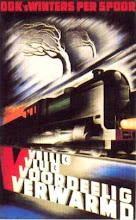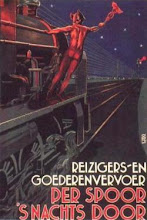A few days ago we visited the largest German train museum. It is situated in the 'Ruhrgebiet' and lies in between Essen, Wattenscheid, Bochum and the river Ruhr.Once you leave the motorway 40, you will drive through residential areas for 15 minutes and then finally a few hairpin bends and you are in the Ruhr-valley in front of the entrance of the train museum.
It is a large terrain and used to be the steam depot of the German railroad in Bochum, including turntable and semicircular engine house. It has also two large rectangular engine houses, a station building. It is a rather different train museum than the Dutch Spoorwegmuseum. Since this train museum displays trains and has not be changed-over into 'an experience and children-playground'.
Not just a few trains, but loads of them to be more precise.
It is fairly difficult to make good photo's in the engine house, since the sun light brightly shines through the upper windows and make the trains reflect in all directions.
Several types of rail buses were displayed. Here a regular bus on train trucks as it operated in the fifties and sixties on remote branch lines.
But also the earlier pig's face from the twenties and thirties.
And some regular passenger coaches for the high speed trains of that era.
Luckily you can enter a few steamer cabins and respect the jungle of valves and pressure displays.
They have several steam engines that are tested and railroad-worthy, which are used for occasional trips. But they also have many steamers and coaches in urgent demand of restoration.
The oldest train car on display is a closed goods car from the 1850's. They estimated the age on several marks on the iron work. The wood side panels and the roof is in dilapidated condition, but it shows how small these early boxcars were.
Here an example of positive discrimination for women; a separate coach department on the high speed coach for women. Why? Smokers and non-smokers as division I understand. Prudery, curiosity or simply a way to avoid harassment? One wonders.
Here the logo of the Royal Prussian railroad company, hand painted on the side of a passenger coach. They needed a few well-trained painters back them to do all the coaches...
A general advice for all persons that try performing on stage without talent. Still relevant in the age of 'the Voice', etc.
And then there was the German crocodile E94 an impressive beauty.
In the end there were too many trains to be photographed. I reckon that they will spend the coming century to restore the rest of the trains that need TLC. There were many nice details to be seen, like the following shots:
In the wealth of train cars that require restoration, they choose to restore a train car that was used by Hitler. This came as a shock. The train car was beautiful restored and shined brightly. The swastika and eagle were prominently visible on the side of the car. Although they explained the historic significance of this train car, I would have preferred to let this car rot and instead restore the orient express sleeping car for instance. Although this is our shared history, it is still discomforting.
Saturday, April 30, 2016
Saturday, April 23, 2016
Lightening the Merkur combined luggage passenger coach
The green passenger coach 9330 and restaurant coach 9331 were already lit. So only the combined luggage passenger coach 9751 still had to be equipped with some internal lights.
Merkur sells two types of interiors for 42 cm (17 inch) long coaches.The 8961 for regular coaches and the 8962 for dining cars. The latter comes with grey tables. Only the 8962 is suitable, but needs a small modification. Two seats need to cut of, to avoid them of obstructing the sliding doors.
After all the screws were loosened to allow the side panel to tilt, the seats would fit in.
Then all the screws and nuts could be tightened again.
The LED strips of Hufing Tronic were glued to the roof and the leads were soldered.
Two blue paper strips were attached with sticky tape to the blue roof line to create a ridge to avoid light shining under the roof slit.The self-made electrical pick-ups were connected and soldered on and then we could let it run.
These passenger coaches are great and just make me happy to see them shine.
Merkur sells two types of interiors for 42 cm (17 inch) long coaches.The 8961 for regular coaches and the 8962 for dining cars. The latter comes with grey tables. Only the 8962 is suitable, but needs a small modification. Two seats need to cut of, to avoid them of obstructing the sliding doors.
After all the screws were loosened to allow the side panel to tilt, the seats would fit in.
Then all the screws and nuts could be tightened again.
The LED strips of Hufing Tronic were glued to the roof and the leads were soldered.
Two blue paper strips were attached with sticky tape to the blue roof line to create a ridge to avoid light shining under the roof slit.The self-made electrical pick-ups were connected and soldered on and then we could let it run.
These passenger coaches are great and just make me happy to see them shine.
Monday, April 04, 2016
Marx lights
Marx was a great American toy company. They were specialised in mass-produced toys with lots of play-value. Although the name amuses me in the sense that it was a toy-manufacturer in a country were McCarthy lived. The geezer that hunted anybody down that only vaguely smelled like a communist. But that is forgotten by most, as is the wall, etc. But some pretty good toys remain. Funny when you think of it; toys out-live ideologies. Anyway, for some unclear reasons, some great Marx toy train accessories became available on my local market and I was fortunate to get a hold on three items. And since these items were not manufactured by Märklin or Lionel, they were cheap and value for money.
I already wired a Marx 416 Floodlight tower from 1938. The patina on the reflectors was so aged (black) that it hardly functioned as a reflector, so I gave it a thorough rub and polish. Since, these were mass-produced I do not mind anyway about patina.
The Marx 436 Searchlight tower is a truly tall structure and once wired on, it lights up the room as a true searchlight should. Unfortunately the glass lens has a crack, but perhaps I can find a replacement somewhere.
And then the Marx 404 automatic block signal with a lever to control the lights and a rheostat to control the light strength. Pretty damn old as well and hence very welcome indeed.
I already wired a Marx 416 Floodlight tower from 1938. The patina on the reflectors was so aged (black) that it hardly functioned as a reflector, so I gave it a thorough rub and polish. Since, these were mass-produced I do not mind anyway about patina.
The Marx 436 Searchlight tower is a truly tall structure and once wired on, it lights up the room as a true searchlight should. Unfortunately the glass lens has a crack, but perhaps I can find a replacement somewhere.
And then the Marx 404 automatic block signal with a lever to control the lights and a rheostat to control the light strength. Pretty damn old as well and hence very welcome indeed.
Subscribe to:
Comments (Atom)




































